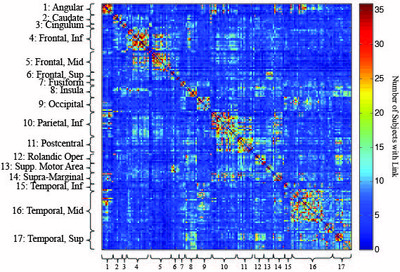Identification and Classification of Functional Modules in the Brain
Jane Wang (Northwestern University), Luis Amaral (Northwestern University, HHMI), James Booth (Northwestern University)
The complexity of the human brain is surpassed only by the large amounts of data being acquired through modern brain mapping techniques. This deluge of data necessitates novel tools of analysis which take into account the vast interdependencies and relationships within and between anatomical regions. Functional connectivity analysis visualizes dynamic patterns of activity acquired through functional magnetic resonance imaging (fMRI) as networks of temporal correlation and takes advantage of multivariate statistical methods to extract information not available with univariate linear modeling. Time series analysis involving coherence and other spectral methods have also been applied to characterize networks of interactions between brain regions (Muller 2001, Sun 2004). At the same time, the mathematical tools of complex network theory can be employed in analyzing these interactions to reveal either local or global topological characteristics thought to be indicative of modes of function or information processing.
We examine changes in language processing over the course of development in children (age 9 to age 15) participating in phonological judgment (rhyming) tasks of visually presented words (Cao 2007, Bitan 2008). We are able to recover and characterize functional modules at multiple scales without the presupposition of previously defined anatomical regions using a combination of multivariate time series analysis techniques as well as graph theoretical measures such as shortest path length, clustering coefficient, and unsupervised community detection. Importantly, our results show that task performance can be predicted by network-level measures at both a global and a local (single link) scale.
References
Bitan, T., Cheon, J., Lu, D., Burman D. D., & Booth, J. R. (2008) Developmental increase in top-down and bottom-up processing in a phonological task: An effective connectivity fMRI study. Journal of Cognitive Neuroscience, 21 (6): 1135-1145.
Cao, F., Bitan, T., & Booth, J. R. (2007) Effective brain connectivity in children with reading difficulties during phonological processing. Brain and Language, 107: 91-101.
Muller, K., Lohmann, G., Bosch, V., & von Cramon, D. Y. (2001). On multivariate spectral analysis of fMRI time series. NeuroImage, 14: 347-356.
Sun, F. T., Lee, M. M., & D’Esposito, M. (2004) Measuring interregional functional connectivity using coherence and partial coherence analyses of fMRI data. NeuroImage, 21: 647-658.


 Latest news for Neuroinformatics 2011
Latest news for Neuroinformatics 2011 Follow INCF on Twitter
Follow INCF on Twitter
